Honda has always been like, well, Honda. Never content unless there was a more complicated engineering solution to an already solved problem, Honda obliterated norms and reached for new frontiers throughout the 1980s. This was clearly evident in today’s bike, a beautiful VR1000R. You see, Honda already had the successful VF lineup in place, including the one liter VF1000F (alongside the 750 and 500 variants). But the “F” model was born and bred to be a streetbike (even though the 750 was transformed into a decent Superbike racer over time). Honda, being a racing company, wanted more than a mere streetbike and needed a platform to express ideas and homologate. Thus, the VF1000R was born.
1985 Honda VF1000R for sale on eBay
Straight off, the R model is far more striking, more racy, than the rather pedestrian F. The swooping bodywork gives it the look of a European endurance racer, which was strictly intentional. The bike retained the same block as the VF1000F, but valve actuation was converted to gear-drive instead of the F model’s chain setup. Straight cut gears off the crank provide the trademark whine that these – and other Honda gear-driven valve train models – are so famous for. Hotter cams were fitted in re-worked heads that provided a higher compression ratio. In all, the completed the head work resulted in a slight bump in HP at the top end. It is true that gear-driven cams have an edge in precision and reliability for a race motor, but the weight, noise and complexity often outweigh the benefits. For the 9 extra ponies created, Honda added some 7 additional pounds to the engine alone.
Speaking of weight, Honda seemingly created the R bike by replacing adequate F model items with heavier pieces. Better front forks added stability – and weight. The cooling system needed to be altered to cope with the new fully-enclosed bodywork. Honda added a second radiator and two additional fans to cope with the heat – which also added weight. The exhaust system was modified to add a collector box and build up ground clearance; the additional pipes / ducting also added mass. While no single component was to blame for the 600+ lbs (wet) weight, you can see how all this added up. The net result was a striking motorcycle that stirred the visual senses. And while it was still a formidable weapon in the canyons, all of that weight (and much of it relatively high up) dulled the senses a bit. It wasn’t all negative – thanks to that slippery bodywork the VF1000R briefly held the top speed title of fastest motorcycle in the world.
From the seller:
Pairing down my collection:This is another of my collection lovingly restored. Many practically unobtainable pieces were installed on this bike to bring it back to like new condition. The fuel tank is brand new NOS! ( I have had amazing luck finding NOS tanks!). I also have a 1982 RM250 NOS tank if anyone is interested and 1984 VF750F NOS tank. The front panels were repainted to like new condition! The bike also has NOS side vents, (unobtainable!!), grips, right switch pod, all turn indicators and tank rubbers. Plus… NOS front forks, yes that is correct, new NOS forks. New petcock and new clutch. Hundreds of dollars worth of cooling system refurbishment. It has a brand new hagon rear shock. New brake and clutch levers plus the master cylinders were rebuilt. The bike is all original and runs perfectly. Again, the cost to restore this bike to its current condition is no where near the purchase price. This is a relative bargain at the opening bid. It can be stored as a museum piece or ridden reliably for fun. Your choice.
No warranty implied or given, (its is a 33 year old bike after all)
The bike is for sale locally so the auction could end at any time. It is a no reserve auction. The price is fair compared to what was spent on it. Good luck….
The VF1000R went through a few iterations, including the headlight configuration. Many will find the dual-headlight R model to be more desirable as it more properly mimics the euro-endurance look. Single headlamp bikes are US only models; managing a full technical program, numerous racing programs and rules AND satisfying the DOT regs were made simpler by this easy move. Dual lamps appeared in the 1986 model year, as US regulations relaxed slightly on this front. Hence, the 1985 model is only a one-eyed wonder. Still this is an awesome piece of kit, and yet another example of Honda flexing their engineering might. These bikes still make a statement today: they look fantastic, are reasonably comfortable, and are more reliable than most would expect. They are also a relative bargain. This particular bike has some nice restoration touches, and has an opening bid of $6500. No takers as of yet, but there is still time left on the auction. Check it out here, and good luck; not many bikes look this good well into their thirties. This is one that will continue to age well….and ride well.
MI








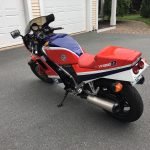
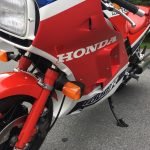
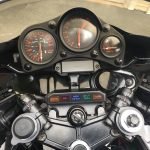
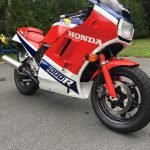
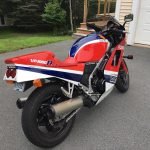
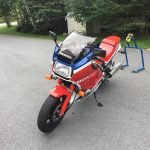
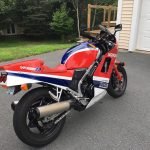

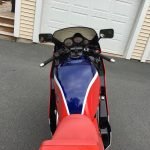








Nice bike, but the tank is off the 1986 model.
Great catch, Jamie – thanks for chiming in!
NOS NOS NOS! I always thought these were interesting bikes. Cool look but bailed after seeing the weight (520lb).
The only Honda I ever lusted after started with RS and won with RG. This one is awesome. But then again, I like curvy girls.
Beautiful bikes, over-engineered in typical Honda fashion of the time, all to the highest standard of finish you’ll find on a mass-produced bike. Makes great noises, but dang, the weight… The bike that could have been… 86 VFR750F, while more pedestrian, is better in every way, save maybe touring. Still, for a relatively inexpensive classic to ride at a reasonable pace on the road and cover some miles, this is one to do it in style.
Beautiful bike.
Fantastic to look at (at listen to), but probably not a lot of fun. If they could have just lopped off about 150 pounds….
David, you’re right, they aren’t a ton of fun. I assembled a basket-case VF1000R back when I had too much time on my hands – some guy completely disassembled a nice one just to try and do exactly what you suggest – drop weight, and immediately lost interest in it. The reassembly process was educational, and a lot of “Jeeze, really, all of THAT is needed on a sportbike?” Once I rode it a couple times I was ready for it to be gone. But still, the build quality is impressive and it just has a good look to it, like a lot of this era Hondas (ok except the US-spec headlight on the ’85 – yuck).
I’ve slowly come to realize that bikes like this, to me anyways, are best admired in someone else’s possession, as the riding experience is a letdown compared to the hopes/dreams conveyed by the looks.
To reply to several comments. Yes Jamie a 1986 tank. Doesn’t matter if it’s NOS it looks wrong for this bike. Good catch. EZ. 520lbs is optimistic. Pushing 550lbs wet, and feels all of 650lbs rolling around the garage or at low speeds. David, I’ve owned 3 of these with my current one a 1984 French bike delivered in Paris and shipped to the US in 1984 with zero miles. All import documentation included. I mention because each I bought out of lust for how it looks and sold because it’s not a fun bike to ride. It’s LOOOONG and I’m 6’4″ with a good reach. I’ve kept the 1984 because I love the proper Euro endurance flat top tank and dual headlights. But I only ride it once or twice a year. If I rode it more I’d sell it for the reasons you cite. But sitting in my shop it’s as good looking as any bike I own.
Why on earth would a seller go to such lengths to brag about NOS parts, only to put the wrong year tank on the bike?? Awful!!
Even when I had my new 86 GSXR750, I had a picture of this on my wall. Beautiful bike. A few years ago I restored a 1000F, very similar, including the incorrectly stated 2nd radiator, basically behind the headlight.